#fashion victims 2007
Photo






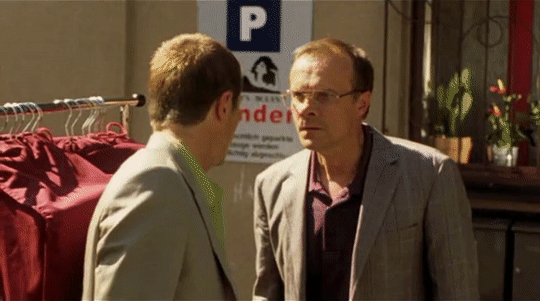
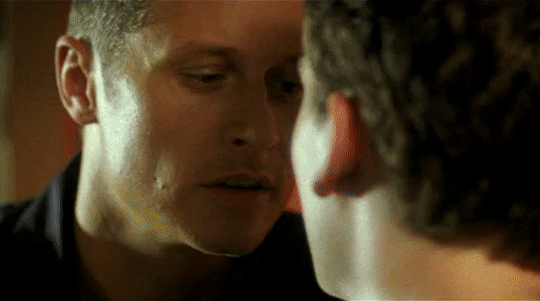

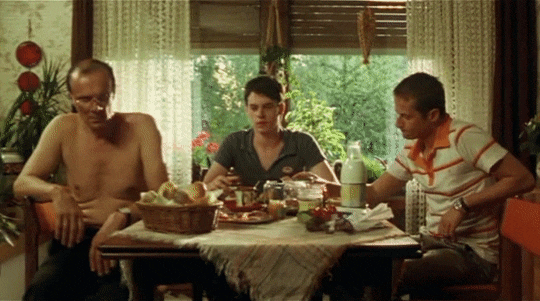
REINE GESCHMACKSACHE (2007)
dir. Ingo Rasper
Wolfgang Zenker, a middle-aged traveling ladies' fashion salesman is in dire straits: his rival Steven Brookmüller is threatening to steal his best customers and he's lost his driver's license. Desperate to stay one step ahead of his young enemy salesman, he cancels his 20-years-old son Karsten's holiday and employs him as an unwilling chauffeur. Things go from bad to worse - the bank is after him, the taxman catches up with him, his wife threatens to leave him, and Karsten falls in love with his rival.
(link in title)
#lgbt cinema#gay cinema#reine geschmacksache#fashion victims#german cinema#fashion victims 2007#lgbt#gay#germany#lgbt movie#gay movies#german movie#lgbt film#gay film#german film#lgbt media#gay media#queer cinema#european cinema#ingo rasper#edgar selge#florian bartholomäi#roman knizka#2007#00s#2000s#00s movies#00s film#2000s movies#2000s films
20 notes
·
View notes
Text

Excerpts from Herbert Tobias entry on Wikipedia:
Tobias was a German photographer best known for his fashion photography during the 1950s. He also drew critical praise for his portrait studies, his photographs of Russia during World War II and his homoerotic pictures of men.
In 1942 Tobias was drafted into the German Nazi army and was sent to the Eastern Front. Shortly before the end of the war he deserted and was captured by the Americans on the Western Front. He was released at the end of 1945.
In 1948, while staying in Heidelberg he began a relationship with a civilian employee of the American Forces of Occupation. In 1950 both men were denounced under § 175 of the German Criminal Code. They moved to Paris.
In Paris Tobias worked as a retouched for German photographer Willy Maywald who introduced him to the fashion world. In 1953 Tobias' first published photos appeared in Vogue. In the same year, after resisting arrest during a police raid on a gay establishment, he was thrown out of France and returned to Heidelberg.
Soon his fashion photographs began to appear in West German magazines. And November 1953, out of over 18,000 entrants, he won first prize in a highly lucrative competition by Frankfurter Illustrierten Zeitung.



Through publication of his work in many high-class magazines Tobias had become, by 1956, an established figure in West German fashion scene.


During the 1960s, Tobias style fell out of favor in Fashion magazines. But in 1972 he found a new avenue for his photographs - various gay and pornographic magazines.


By 1981, with some high profile exhibitions of his work in Amsterdam and Berlin, Tobias working on a book with a collection of his nudes.
Tobias became seriously ill in February 1982 and died in August of the same year. He was one of the first high-profile victims of AIDS in Germany. He was buried in Altona Cemetery in Hamburg. In 2007 his grave site was declared an Ehrengrab ("grave of honour") by the Hamburg Senate.
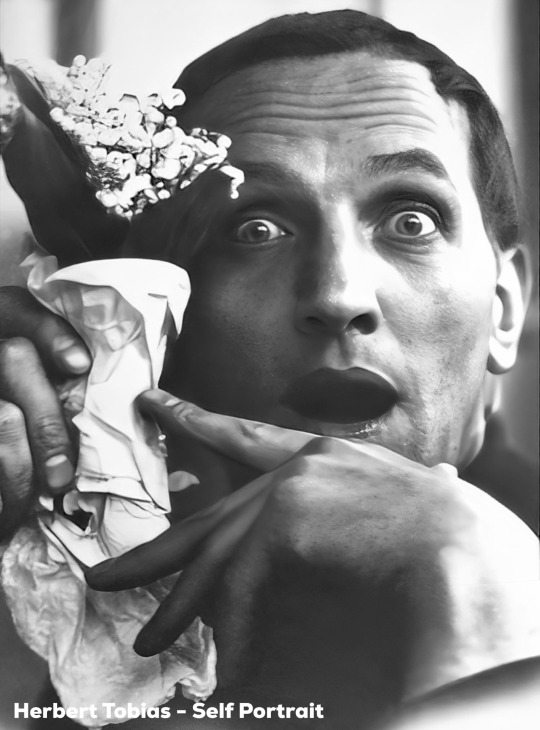
#Ehrengrab#gay icons#Herbert Tobias#German photographer#fashion photography#vogue#homoerotic#German Criminal Code#AIDS#resisting arrest
7 notes
·
View notes
Text
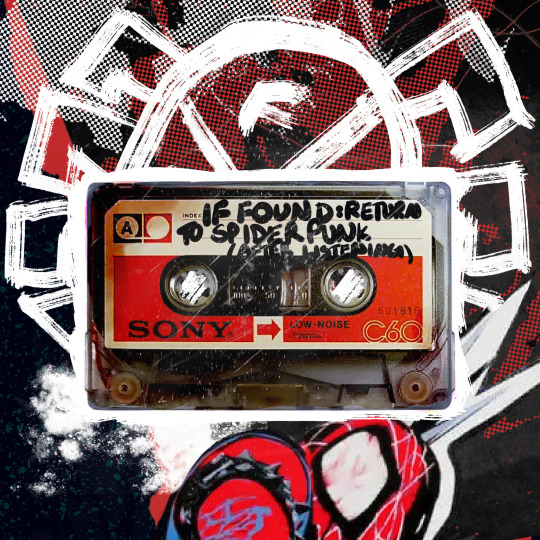

IF FOUND: RETURN TO SPIDER-PUNK (AFTER LISTENING)
You know who has never made a fanmix and doesn't know how they work? Me. You know who made one? Also me.
Imagined as a C60 cassette tape, A side 30 minutes/12 songs, B side 30 minutes/11 songs Because. A side is more solidly just punk music (esp older stuff), B side has some more alternative rock-ish stuff, newer stuff, etc Because.
Listen here on Spotify, OR if you are into the old-fashioned fanmix things, you can download it here (mostly with shitty 192 bitrates but whatever) with the album art, divided into 2 "discs" (A side/B side), etc. There was also one specific version of one song Spotify didn't have so the uploaded version has the correct one but the version Spotify does have is. Fine.
Disclaimer: I haven't been really into punk music for 15 years or so, aside from a few favorites that are in the regular rotation, but it was a chance to listen to a lot of different stuff incl new stuff and pick some songs so uh anyway I had fun.
Tracklist & album art credits below the cut (warning for uh. language in band names and track titles? It's punk music.)
A side:
Punk Is Dead - Crass
C.I.D. - UK Subs
Rebel Girl - Bikini Kill
Should I Stay Or Should I Go - The Clash
Attitude - Bad Brains
International News - National Wake
17 Years Of Hell - The Partisans
Gimme Gimme Gimme - Black Flag
Shitlist - L7
Wankers - The Exploited
Rancid - Roots Radical
Hard Action - Pure Hell
B side:
Don't Follow Me - Rebelmatic
Coming Down to Beijing - Brain Failure
Criminal - Generacion Suicida
Black Union Jack - Half/Time
Uraraka - Amano Tsukiko
Provoke You - Sihasin
Crudo Soy - Los Crudos
Voice of Memphis - Negro Terror
Fly - Cherry Filter
Rock-N-Roll Victim - Death
Fuck These Fucking Fascists - The Muslims
Album Art Credits:
Expose42 "Checkers" Textures (I cannot find these specific textures anymore - they were apparently downloaded in 2011 - but my credit file says they're by Expose42)
Miss Minn - Bleeding Love Tutorial Textures (I apparently downloaded these in 2007 and can't seem to find this person anymore, if anyone has a current link for them, let me know)
Official Hobie Brown/Spider Art
Kyle's Brushes
Sony Cassette Tape (product image from yahoo search)
#fanmix#playlists#hobie brown#spider man#across the spiderverse#astv#spiderverse#atsv hobie#hobie brown atsv#punk#uhh sorry to all the people who followed me for star wars#there will be some star wars posting for Finn Week probably#but I also signed up for the spiderverse Big Bang so there will also be spiderverse content coming up#the cassette tape thought process was basicaly#living in fascist dictatorship = probably don't want to have or carry a cellphone when Spidering#(also depending on what year it is in Spider-Punk verse: it is unclear)#but portable cassette players don't skip like a CD player would#again depending on the year an mp3 player would have been an option I guess but#the restriction of 2 sets of 30 minutes of music was helpful for me#so here we are
13 notes
·
View notes
Text
TROUBLE WITH THE CARVE
Opening this week:

Thanksgiving--Slasher movies of the '70s and early '80s were often holiday-themed. Black Christmas, Halloween, My Bloody Valentine, Silent Night, Deadly Night, New Year's Evil and April Fool's Day are all examples, while Friday the 13th and Happy Birthday to Me, while not strictly about holidays, are still tied to special dates and the convenient unity of time they provide. But Thanksgiving was somehow the major holiday the genre seemed to miss.
There actually were a couple of little-remembered attempts--Home Sweet Home in 1981 and Blood Rage in 1987. But neither seemed to count, perhaps because they didn't use the holiday in the title, or perhaps because they didn't sufficiently exploit the gruesome possibilities offered by the day's rituals. Whatever else may be said about it, the newly-made but self-consciously old-school slasher picture Thanksgiving works hard to include every classic Turkey Day trope.
A shoppers' riot and stampede at a store that shouldn't be open on Thanksgiving leads to bedlam and grisly death in a small Massachusetts town. "One Year Later"--as a subtitle traditionally informs us--a figure in the mask and garb of a Pilgrim skulks around exacting vengeance on those deemed responsible for the disaster. Everything eventually converges in a ghastly sit-down dinner.
The film traces its inception back to 2007, when two movies, the Robert Rodriguez shocker Planet Terror and Quentin Tarantino's stunt thriller Death Proof, were released as a double feature under the joint title Grindhouse. In and around the two features, the show included several "fake trailers" for fictitious grindhouse-style movies. Two of these have already wagged the dog as the basis for real features, Machete (2010) and Hobo With a Shotgun (2011); Thanksgiving marks the third.
Directed by Eli Roth, the Thanksgiving trailer in Grindhouse captured the nastiest, most low-rent atmosphere of a vintage gore movie, complete with scratched, faded footage, some really sleazo shocks, and the smarmy, glottal tones of the narrator (Roth himself?). You could almost believe it wasn't a put-on.
The new feature, directed by Roth from a script by Jeff Rendell, doesn't try for this level of faux-authenticity. The setting is contemporary, the budget clearly comfortable, and cell phones and social media figure prominently in the plot. But the movie still has a nice old-fashioned pace and structure and flavor, and the nostalgia of this is much of what makes it unsavory fun.
I'll admit that in recent years I've largely lost my stomach for slasher flicks. Moreover, I thought Roth's 2002 debut feature Cabin Fever was an interesting misfire at best, and I took a pass on his 2005 torture flick Hostel. But he strikes an affectionate tone here, and he employs techniques that distance us from compassion for the victims. Most simply and effectively, he makes many of them, especially the early ones, deeply and amusingly unsympathetic.
The cast is livened up by some veterans, like Patrick Dempsey, Rick Hoffman and Gina Gershon, and the "final girl" (Nell Verlaque) has a lovely presence, and unlike so many heroines back in the day, she fights back, resourcefully and successfully. It was also great to see Lynne Griffin, the first victim from 1974's Black Christmas--and the Hamlet figure in the Bob and Doug McKenzie movie Strange Brew--in a bit here.
Most notably, the film keeps it light. As with two other movies from earlier this year, Cocaine Bear and Renfield, Thanksgiving goes in for extreme, over-the-top splatter effects, and they aren't scary, nor do they seem meant to be. They aren't even all that gross. There's no visceral substance to them; the bodies of the victims go to pieces like gingerbread men, and the effect, seemingly deliberate, is cartoonish slapstick. We're about as likely to take their suffering seriously as that of Wile E. Coyote.
Maybe it's how entertainment like this works best: as a sort of anarchic Punch and Judy show, using humans instead of puppets. Like Thanksgiving dinner, it wouldn't be healthy to consume this sort of thing every day, but about once a year, it can hit the spot.
#thanksgiving#eli roth#patrick dempsey#rick hoffman#nell verlaque#addison rae#gina gershon#jeff rendell#quentin tarantino#robert rodriguez#grindhouse#cocaine bear#renfield
4 notes
·
View notes
Text
RESEARCH AND RESOURCES.
these go over mainly victorian era subjects. i tried to find something for every character in the show, though this is 100% an ongoing list. feel free to ask for something in particular or send me questions about the resources here! this is forever a work in progress.
THE SHOW:
1982 proshot ( i very much recommend this version! the portrayal of johanna is not my favorite but an.gela l.ansbury is as wonderful as always and is very loyal to the original broadway production -- which is a positive and a negative )
2007 movie ( if you are just getting into this musical, i recommend watching the movie first. it'll get you into it. this is my favorite portrayal of johanna and anthony and where johanna's fc comes from. i have several gripes with the movie however and i only tell you to watch the movie first so you can enjoy it. you won't be able to after watching the musical. if you are senstive to large amounts of gore like i am, shoot me a message and i will give you timestamps to skip! )
1980 tour cast recording
original broadway cast soundtrack
original broadway cast
score
fourth revision of 2007 movie script ( interesting to take a look at and see the changes made between the two versions )
a string of pearls ( penny dreadful that's the source material for the bond play which then turned into the musical )
FASHION.
getting dressed in the 1840s -- queen victoria ( video )
getting dressed in the 1840s -- prince albert ( video )
bringing history to life: 1842 day dress ( video )
dressing up a 1840s gentleman ( video )
dressing up a middle class lady, 1848 ( video )
1840s winter get ready with me ( video )
1840-1849 fashion history timeline
1840s in western fashion ( wikipedia article so take with a grain of salt, but as is with any wikipedia artcle, look at the sources cited! )
the writer's guide to 1840s women's fashion
1840s extant dress
WORKHOUSES.
the victorian workhouse
workhouses.org.uk ( excellent resource going over just about everything workhouse related. uniforms, schedules, children, food etc. )
what was life actually like in a victorian workhouse? ( documentary )
24 hours in the past episode on victorian workhouses ( the rest of the show in on youtube and this is the final episode. spoiler warning, though i didn't find it too bad. i quite enjoy the rest of the show as well! it gives a good look into lower-class victorian england. )
punishments in the victorian workhouse ( documentary )
the psychological torture of the victorian workhouse ( documentary )
PRISON.
victorian prisons and punishments
the victorians and australian penal colonies
convicts and decolonization of australia, 1788-1868
convict transportation peaks
british convicts to australia
australian penal colonies
what was life like for victorian convicts to australia? ( documentary )
women, crime and custody in victorian england ( no downloads are available, however it may be at a local library )
CLASS.
victorian middle class
working class and the poor
COURT.
judge and jurist in the reign of victoria
courtroom experience in victorian england
judicial discretion and sentencing standards
victorian courts
BARBERS.
barbers and their shops in early modern britian
history of barbering
SAILORS.
life at sea in the age of sail
life on a ship during the early 1800s
living conditions in the 19th century us navy
life on a sailing ship in the early 1800s
WOMEN.
the female body in the nineteenth-century
woman as victim and martyr
a selection of works about women in the age of queen victoria
the daughters of england ( really good rescource on how women were treated during the era. i believe it was written in the late 19th century. )
gender roles in the 19th century
prostitution
governesses
a brief history of midwifery in america ( included since america and england were fairly similar at the time )
19th century childbirth
women, menstruation and 19th century medicine ( access through school or library )
the evolution of menstrual education in england 1850 to 1930
how did victorian women deal with their periods? ( video )
SEXUAL ABUSE AND SEX.
*if you have any questions about the resources linked under this section, let me know! i will be happy to give you more specific warnings or details on the subject manner.
victorian prostitution
placing childhood sexual abuse in historical perspective ( for obvious reasons please do not read this if you are sensitive to the topics of child sexual abuse, sexual abuse, or anything of that sort )
the history of early life trauma and abuse ( warnings for abuse of all kinds and trauma in young children. has to be accessed through an institution. )
victorian sexualities
sexual molestation of children: historical perspectives
the criminal law amendment act, 1885 ( this law raised the age of consent for girls from 13 to 16. the age of consent was twelve previously. )
mary ellen wilson ( her case was one of the promptings to raise the age of consent )
offences against the person act 1861 ( wikipedia article, but it gets the gist of the law )
the maiden tribute to modern babylon ( series of articles to expose the young girls forced into sex work. this was another reason why the criminal law amendment act, 1885 passed. HUGE WARNING for these articles. this is an incredibly heavy series of works. their importance can't be understated, but i wasn't able to get through them. if you are particularly sensitive to topics of child sexual abuse or sex work, please keep yourself safe and do not read these, but this goes for anyone. take care of yourself. )
the victorian's sex lives ( documentary. mostly goes over examples of wealthier couples. )
kissed against her will
FAMILY.
advice to young men ( written in the 19th century. author gives advice to young men and young women of the era on marriage, family life, and running a hosuehold. )
fatherhood and divorce laws
19th century childbirth ( warnings for childbirth and pregnancy )
victorian childbirth ( warnings for childbirth and pregnancy )
miscarriage in nineteenth century america ( warnings for pregnancy and miscarriage. some of the methods male doctors employed to deal with miscarriage were brutal. keep that in mind. )
lost: miscarriage in nineteenth century america ( warnings for pregnancy and miscarriage. some of the methods male doctors employed to deal with miscarriage were brutal. keep that in mind. )
coping with miscarriage in the nineteenth cenrtury ( warnings for pregnancy and miscarriage. some of the methods male doctors employed to deal with miscarriage were brutal. keep that in mind. )
SUICIDE.
suicide in england and wales 1861-2007
rodenticide toxicity
what happens if a human eats rat poison?
sodium hydroxide
MENTAL INSITUTIONS.
the woman in white ( fictional novel published in 1859 which exposed how poorly mental asylums treated their patients. )
ten days in a madhouse ( expose written by nellie bly about the treatment of patients in blackwell's island insane asylum. warnings for torture and abuse of all kinds. it's a fairly short read. )
a victorian mental asylum
the social history of psychiatry in the victorian era
victorian oppression of women through psychiatry
madhouses, mad-doctors and madmen: the social history of psychiatry in the victorian era
mania, dementia, and melancholia in the 1870s
19th century mental health
victorian women and insanity
bbc mental a history of the madhouse ( documentary )
victorian mental health and women
insanity terminology in the 18th and early 19th century
hysterical victorian women
from bethlehem to bedlam - england's first mental institution
MISC.
health and hygiene
popular culture
why was baking the deadliest job in the victorian era? ( bakers in the countryside. documentary/reality show. )
what life was like for a baker in the victorian era ( industrial bakers. documentary/reality show. )
#gosh i don't know how to tag this#this took me like two hours :')#*❈ ‣ whence comes this melody constantly flowing? — ( meta. )#long post tw
3 notes
·
View notes
Text

Wasalu Muhammad Jaco (born February 16, 1982) known by his stage name Lupe Fiasco is a rapper, singer, record producer, and entrepreneur. He rose to fame in 2006 following the success of his debut album, Lupe Fiasco’s Food & Liquor. He performs as the frontman of the rock band Japanese Cartoon under his real name. As an entrepreneur, he was the chief executive officer of 1st and 15th Entertainment.
Raised in Chicago, he developed an interest in hip-hop after disliking the genre for its use of vulgarity and misogyny. After adopting the name Lupe Fiasco and recording songs in his father’s basement, he joined a group called Da Pak. The group disbanded shortly after its inception, and he soon met rapper Jay-Z who helped him sign a record deal with Atlantic Records. In September 2006, he released his debut album Lupe Fiasco’s Food & Liquor on the label, which received three Grammy nominations. He released his second album, Lupe Fiasco’s The Cool, in December 2007. The lead single “Superstar” became his first top 40 hit on the Billboard Hot 100. After a two-year delay, his third album, Lasers, was released in May 2011 to mixed reviews, it became his first album to debut at #1 on the Billboard 200. The album was preceded by his highest charting single, “The Show Goes On”, which peaked at #9. His latest album, Drill Music in Zion, was released in June 2022.
He has pursued other business ventures, including fashion. He runs two clothing lines, Righteous Kung-Fu and Trilly & Truly; he has designed sneakers for Reebok. He has been involved with charitable activities, including the Summit on the Summit expedition, and in 2010 he recorded a benefit single for victims of the 2010 Haiti earthquake. He is noted for his anti-establishment views, which he has expressed in both interviews and his music. #africanhistory365 #africanexcellence
1 note
·
View note
Text
Since 2007 Lewis Hamilton has barely been shown respect by the sport of F1.
Since 2007 this man has been painted a villain.
Since 2007 he has been isolated and on the receiving end of endless and pointless vitriol.
He’s been in this sport for almost two decades and people still refuse to acknowledge his talent, consistently saying he only got his championships cause of the car. For 16 years on a public level this man has been the victim of overt, covert, interpersonal, and systemic racism.
And to see not once, but twice, the team he has brought glory to has left him alone on the podium? The disrespect is palpable. Lewis already has lost countless friends in this sport, and has continued to be isolated by others and had to isolate himself in a move of self preservation. But to see his own team continue the cycle is disgusting.
I don’t care whether you like George or not, even I like him and think he is a good driver but at the end of the day one of them has the experience and success Mercedes needs to get on top again (something George will also feel the benefits from). But, instead of prioritizing that person, instead of listening to his advice and critiques, Mercedes has spat in his face for the better part of 2 years. Mercedes will continue to shoot itself in the foot and take George down with them (in Ferrari fashion) if they don’t learn to listen to their multi-world champion, and today was prime example of that.
Lewis Hamilton deserves much more respect than anyone in the F1 community has ever given him because being a black man in a sport created and surrounded by rich people and white folks is a level of stress none of us will ever understand.
I implore you all to examine why you hate Lewis Hamilton and his fans so much. Ask yourself if his fans reactions are a direct foil to the lack thereof when his is met with injustice. Ask yourself if the behavior you hate is possibly reactionary.
The moment Lewis Hamilton stepped into Formula 1, it stopped being just a sport. It became a microcosm of racism, reflective of the racism black people are met with daily in a “post” colonial world.
It might make you uncomfortable, I want you to sit in the discomfort. You might want to come at me with “not everything is about race.” But remember everything was made about race when the first “explorer” decided to step foot in Africa.
All this to say, Lewis Hamilton is a patient, kind man despite his circumstances. The lack of reciprocation of that is not only heartbreaking, it is vile.
2 notes
·
View notes
Text



.
Wednesday Wanderings and Wonderings - The Passage Edition
Passage Brady (43, rue du Faubourg-Saint-Martin - 46, rue du Faubourg-Saint-Denis 75010 Paris)
Not quite the same type of passages found in the 2nd and 9th district, Passage Brady is often referred as “Little India". Since 1973 you will find the largest choice of Indian products in Paris at the supermarket Bazar Velan, an institution. In the 90s it had a bad reputation but
In the early 1820s, Mr. Brady, a merchant living in the faubourg Saint Denis, formed an ambitious project for a covered passageway, the longest in Paris. He imagined a real little village made up of one hundred and thirteen stores with lodgings on the floor. Brady joined forces with M. Briavoine, a merchant, and work began in 1825. The shopping mall was to extend from the rue du Faubourg Saint Denis to the rue du Faubourg Saint Martin. During the course of the work, the promoters decided not to cover the entire passage. The covered western section and the open eastern section were not perfectly aligned and the irregularity of the layout was compensated for by the construction of a rotunda at the point of deviation, which marked the junction between the two sections.
The Brady Passage was inaugurated on April 15, 1828. At the beginning, there were reading rooms, elegant stores and even a bathhouse. But the passage struggled to find its clientele. Very quickly out of fashion, victim of commercial failures, the situation deteriorated. As early as 1834, classic clothing and leather goods gave way to thrift shops and dubious stalls. In 1852, the Brady passage fell victim to the great Haussmannian works. The piercing of the boulevard de Strasbourg, which extended the boulevard Sébastopol, cut it off from its central part and made the rotunda disappear. The covered gallery is definitively removed from the open-air portion and develops into an autonomous alley.
In the early 90s, dubious hotels have opened their doors and sleep merchants have housed entire families in precarious conditions.
In November 2007, a major fire broke out in degraded housing and five people died. Following this terrible accident, controls were reinforced. As early as 2009, funds are gathered to consider a thorough renovation. The phase of work begins in 2013. Since March 2002 The passage Brady is classified as a Historic Monument.
** But what is a passage? It is a private road open to the public, a shortcut between several roads, whether covered or not. As a pedestrian space, the passage can house both commerce and housing. Only the abundant decoration and the luxury of the stores differentiate a gallery from a passage. It’s the ancestor of today's shopping malls, the unique charm of Parisian covered passages will immediately transport you to the 19th century (Previous Posts)***
#CelineIsNotAnExpatAnymore#France life#Paris#CelineWandersAndWondersInParis#CelineAndPassagesInParis
3 notes
·
View notes
Text

The Canal Saint-Martin Paris, France. Patrick Kovarik/AFP/Getty Images
Bicycle Graveyards: Why Do So Many Bikes End Up Underwater?
Every year, thousands of bikes are tossed into rivers, ponds, lakes and canals. What’s behind this mass drowning?
— By Jody Rosen | Thursday July 28, 2022
Every decade or so, the city of Paris drains the Canal Saint-Martin. The nearly three-mile-long waterway, which runs south across a swathe of the Right Bank, was originally constructed to keep Paris clean, supplying fresh water to a city plagued by cholera and dysentery. But for the two centuries of the canal’s existence, it has often served a different – in fact, opposite – function. It is a dumping ground, a big liquid trash can. The periodic draining is therefore also an unveiling. The water recedes, and the stuff kicked or heaved or furtively dropped into the canal over the preceding few thousand nights is revealed.
When the canal was emptied in 2016, crowds gathered on footbridges and along the quais to watch cleaning crews trudge through the mud and clear out the junk. There was lots of it. Mattresses, suitcases, street signs, traffic cones. A washer-dryer, a tailor’s mannequin, tables and chairs, baths, toilets, old radios, personal computers. A number of vehicles, none of them designed to travel on water, were pulled from the mire. There were baby strollers, shopping carts, at least one wheelchair and several mopeds.
Today, the streets abutting the canal in the 10th arrondissement are among the most fashionable in Paris, lined with chic cafes and restaurants. But late at night the area retains some of the dank atmosphere of bygone years, when it was a scruffy quartier populaire and often served as the setting for noir films and detective novels. In those pulp fiction tales, dark secrets emerge from the Canal Saint-Martin murk. The murder mystery in Georges Simenon’s Maigret and the Headless Corpse is set in motion when the police dredge up a dismembered body near the Quai de Valmy. No human remains were discovered during the 2016 cleaning, but workers did find a handgun in one of the northernmost locks. Later, officials announced that a rifle had also been found.
The most plentiful items in the canal – other than wine bottles and mobile phones – were bicycles. Nine years earlier, in 2007, Paris had launched a bike-share scheme, Vélib’, in which 14,500 rental bicycles were introduced across the city. As the waters were drawn off, the skeletal forms of dozens of Vélib’ cruisers could be seen half-buried in the sludge on the canal floor. There were scores of other bikes, too, of various makes and vintages, some of which appeared to have been maimed before being sent to their watery grave. There were bikes with bent and twisted wheels, or no wheels at all. There were bikes whose wheels and frames were intact but whose stems and handlebars were missing: headless corpses.
Some of the bikes may have ended up in the canal by accident. There are numerous scenarios that can result in the unintentional depositing of a bicycle in a body of water. Cyclists lost in the dark or disoriented by fog steer bikes off towpaths into canals. Drunk cyclists fall from bridges. Thieves fleeing police by bicycle swerve into the river. The luckier victims manage to pull themselves – and, sometimes, their bicycles – back to dry land, but these incidents can have calamitous outcomes. A scan of newspaper archives turns up grisly stories with vivid headlines: “Boy drowns in canal: found with his bicycle”, “Woman cyclist drowned: blown over parapet of river bridge”, “Rode into canal in blackout: Gloucester man drowned cycling to work”, “Cyclist drowned, but how?”. Some despondent souls have deliberately pedalled into the depths. In the fall of 2016, a 38-year-old woman left a suicide note in her apartment in DeWitt, New York, not far from Syracuse. The woman then went to a nearby state park, where she handcuffed herself to a mountain bike and rode into a lake. Her body, still manacled to the bike, was found a week later.
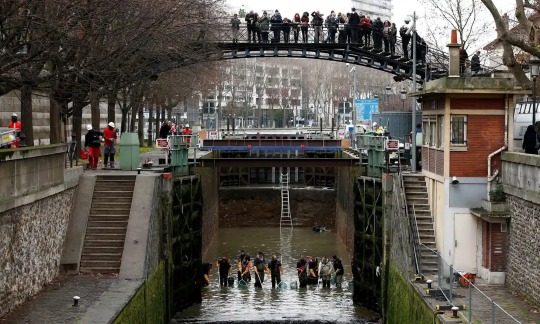
Canal Saint-Martin maintenance in Paris in 2016. Photograph: Yoan Valat/EPA
As for the bikes in the Canal Saint-Martin: it seems safe to assume that most of them wound up in the water neither by accident nor under tragic circumstances. For those disposed to random acts of hooliganism – who, perhaps, sublimate the compulsion to do violence to sentient beings by trashing insentient stuff they happen across – a bike presents an inviting target. The growth of share schemes like Vélib’ has put more bicycles on the streets of the world’s cities, and these bikes may strike vandals as fair game, since they are not owned by individuals. The introduction of dockless hire bikes, which sit on sidewalks rather than secured in docking stations, has removed any impediment to such forms of self-expression as wheel bashing, frame mauling and brake-cable clipping. Some people take a more whimsical approach: dangling bikes from wrought-iron fences, perching them atop traffic lights and bus shelters, sticking them in high tree branches to roost like nesting pterodactyls.
Throwing a bicycle into the water is a specialised sport, which offers its own peculiar satisfactions. On social media reels, videos show pranksters rolling bikes down embankments into lakes, tipping bikes over quayside railings, tossing bikes into rushing whitewater. In one clip, a teenage boy faces the camera holding a weather-beaten blue BMX. “Mike, this is your bike,” he says. “It’s been in my garage, and I don’t really want it. So I’m gonna throw it off the jump in the pond. I hope you don’t mind.” With a running shove, the boy sends the riderless bicycle somersaulting off a wooden plank into the water. Whoops and laughter can be heard in the background as the jittery camera records the bike’s quick demise, the rear wheel bobbing briefly above the surface before vanishing into the gulping pond – a slapstick murder. I won’t lie: it looks fun.
Clearly, for many, it is fun. In some places, it’s an epidemic. An Englishman who grew up in Peterborough, Cambridgeshire, recalled that in the 1960s local boys would steal bicycles and go joyriding; the escapades would end with the ritual dumping of the bikes in the River Nene. This practice was discovered when “a boat snagged on … an underwater mountain of bicycles”.
In Amsterdam, drowned bikes were at one time heaped so high in the city’s 165 canals that they scraped the underside of flat-bottomed barges. The solution was fietsen vissen, “bicycle fishing”. In the old days, this task was accomplished by freelance scavengers who plied the canals in rowboats, using hooked poles to extract bikes, which were sold for scrap. In the 1960s, Amsterdam’s water agency assumed responsibility for bicycle fishing. These days, a corps of municipal workers trawl for drowned bikes on boats equipped with cranes attached to hydraulic claw grapples. The problem is not as severe as it once was, but fishers still pull 15,000 bicycles from the canals each year. It is a unique Amsterdam spectacle that never fails to draw a crowd of onlookers: the big metal claw rising out of the water with a dripping haul of wheels and frames and handlebar baskets. The bikes are dropped into garbage barges and transported to scrapyards for recycling. It is said that many of the recycled bikes are turned into beer cans.
In Amsterdam, as in Paris, no one is quite certain why or how so many bicycles wind up in the water. City officials ascribe the problem, vaguely, to vandalism and theft. Alcohol surely plays a role, and there could well be a kind of ecosystem at work: a bicycle is pulled from the canal and recycled into a beer can, whose contents are guzzled by an Amsterdammer, who, weaving home at the end of a dissipated night, spots a bicycle and is seized by an impulse to hurl the thing into a canal. The writer Pete Jordan, in his charming book about Amsterdam and cycling, In the City of Bikes, devotes several pages to bicycle drowning, linking it, in part, to the city’s tumultuous political history. In the 1930s, communists pranked fascists by tossing their bicycles into the Prinsengracht, the “Prince’s Canal”; during the German occupation in the second world war, resistance leaders called on Amsterdammers to dump their bicycles into canals to keep them from falling into the hands of the Nazis, who were confiscating bikes. Jordan also cites the 1963 Dutch novel Fietsen naar der maan (Cycling to the Moon), which depicts bicycle drowning as an elaborate form of theft: a bicycle fisher secretly knocks bicycles into an Amsterdam canal at night; he returns the next morning to retrieve the bikes, which he sells to a fence.
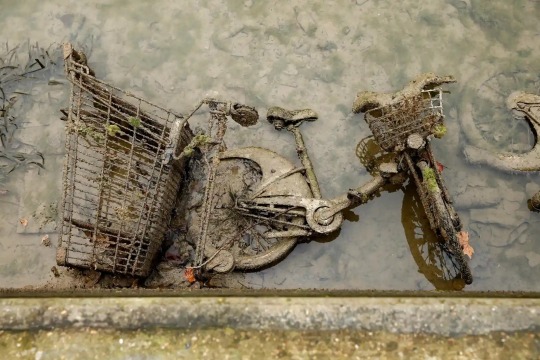
A bike uncovered during maintenance of Canal Saint-Martin in Paris in 2016. Photograph: Yoan Valat/EPA
The situation in Amsterdam is perhaps best explained by simple maths. There are an estimated 2m bicycles in the city and 30 miles of canals, and logic dictates that there will be some spillover of one into the other. When an Amsterdammer needs to get rid of an old bicycle, a waterway will often provide the most convenient dumpster. The Dutch newspaper Trouw once characterised Amsterdam’s canals as “those traditional garbage cans where we take our visitors on boat trips”.
But this is not just a Dutch phenomenon. In 2014, the Tokyo parks department became aware that non-native fish had been introduced into the large pond that sits in the centre of Inokashira Park, in the city’s western suburbs. The fish, which were thought to have been put in the water by former owners, were causing environmental damage; officials decided to drain the water to remove the fish. But when the pond was emptied, another kind of invasive species was found: dozens of bicycles. The discovery took many in Tokyo by surprise. Sanitation workers had long complained about the abandoning of unwanted bikes in streets and alleys and parking lots. But the dumping of bicycles in bodies of water was a largely unknown – by definition, hidden – custom. How many more bicycles are covered by the world’s waters, concealed by ponds and lakes and canals, by the Danube, the Ganges, the Nile, the Mississippi?
A lot, it is reasonable to surmise, and the numbers appear to be growing as bike-sharing schemes proliferate. During the first year Vélib’ was in operation, Paris police officers fished dozens of bikes out of the Seine. A bike-share company stopped doing business in Rome after too many of its bicycles were thrown into the Tiber. “Dockless bikes keep ending up underwater,” reported the Boston Globe in 2018, soon after the arrival of bike-share firms in Boston and its suburbs. In February 2019, in New York, a Citi Bike cruiser that had evidently spent some time in the Hudson River appeared overnight at a docking station on Manhattan’s Upper West Side. The bicycle was blistered with barnacles and molluscs; its spokes were covered in seaweed. A Hudson River conservancy expert was asked by the website Gothamist to assess the length of time the bicycle had been underwater. “Based on the oysters on the handlebar, we’d say [the Citi Bike has] been in the river since at least August, potentially since June,” the expert said.
The same problem has been reported in Melbourne, in Hong Kong, in San Diego, in Seattle, in Malmö̈, Sweden, and in many other cities. In Britain, hire bikes have been pulled from canals in London and Manchester, and from the Thames, Cam, Avon and Tyne rivers. In 2016, the Canal & River Trust, which holds the guardianship over waterways in England and Wales, released transfixing underwater video footage of fish drifting lazily along the floor of a canal, past bicycle wheels fringed with algae.
The most dramatic reports of bicycle dumping and dredging have come from China. In 2016 and 2017, the then-largest bike-sharing companies in the world, Ofo and Mobike, salvaged thousands of their dockless rental bikes from rivers in southern China. One widely circulated video showed a man on a busy pedestrian footbridge tossing Mobikes into Shanghai’s Huangpu River. Other viral clips caught such spectacles as the demolishing of share bikes by a group of children and a share bike being battered by a hammer-wielding elderly woman. Share bikes were stolen and stripped for parts, thrown under automobiles, buried in construction sites, and set on fire. The vandalism has prompted soul-searching in China. “It is common to hear people describe bike-sharing as a ‘monster-revealing mirror’ that has exposed the true nature of the Chinese people,” the New York Times reported in 2017.
Or perhaps that mirror reflects larger truths about our times. The man who was filmed throwing bicycles into the river in Shanghai was a migrant from Hong Kong who told journalists he had destroyed an additional nine Mobikes with a hammer. The man said that he was infuriated by the company’s violation of users’ privacy: “The chips in Mobikes are unsafe and disclose users’ personal information, such as their locations.”
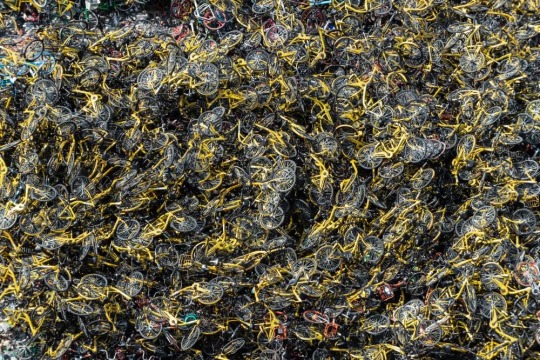
Abandoned shared bicycles in Shanghai. Photograph: Jackal Pan/Getty Images
Theoretically, a bike-sharing programme is an initiative that makes city life not only more convenient and more pleasurable but more ecological and more equitable, fairer and freer. In fact, many bike-share schemes are public-private partnerships, sponsored by multinational banks whose logos emblazon the bicycles’ mudguards. The dockless bike-share industry is dominated by tech companies that have flooded streets and sidewalks with bikes, often before regulations or infrastructure are in place. Most dockless systems are app-based and offer a familiar digital age trade-off: ease and convenience at the expense of privacy. The apps collect a rider’s personal data, and the bicycles use built-in GPS chips and wireless connections to transmit that rider’s location as frequently as every few seconds. A bicycle that spies on its rider – it’s quite a plot twist for the machine that, once upon a time, in the heady days of the late-19th-century bicycle boom, promised a previously unimaginable kind of personal freedom.
In China, more than 70 dockless bike-share startups, backed by more than $1bn in venture capital, pushed millions of bikes into cities in 2016 and 2017. Supply swamped demand, and the bikes, quite literally, piled up. On the outskirts of Beijing, Shanghai, Xiamen and other cities, tens of thousands of impounded share bikes, many of them brand new, filled vast vacant lots, towering dozens of feet above the ground in enormous agglomerations. These places have been called “bicycle graveyards”, but in overhead photos and videos captured by drone, they often looked more like fields of flowers: the bright yellow and orange and pink hues of the bike frames stretched out for acres, like a lurid carpet laid over the land. History-minded viewers of these images might think of that archetypal speculative bubble, the “tulip mania” that captivated the Dutch republic in the 17th century.
The bicycle isn’t the only form of transport that has been subject to boom-bust cycles and waves of vandalism. In recent years, the introduction of electric scooter sharing programmes to cities has brought anger from pedestrians who resent the machines cluttering pavements and motorists who regard them as unwelcome on roads. Reports have flooded in from across the globe: in Los Angeles, e-scooters have been shoved into public toilets, buried in the sand, and thrown in the ocean; in Cologne, a team of divers discovered hundreds of e-scooters lying at the bottom of the Rhine, secreting pollutants into the river from leaking battery casings. The “scooter rage” has prompted leading e-scooter companies like Bird and Lime to manufacture new models with improvements designed to thwart those who would cut brake cables, remove QR codes, and perform other acts of sabotage.
These attacks might be viewed as guerrilla assaults in a larger war: a global battle over the right to roadways that has reached a new pitch in recent years, as cities rethink their relationship to cars, install cycling-friendly infrastructure, and embrace bike share programmes and other initiatives to encourage “micromobility”. Perhaps the most noteworthy development is the advent of the e-bike – bicycles with a battery motor – whose astonishing popularity around the world suggests that a new cycling revolution – potentially the most significant since the storied 1890s bike boom – may be nigh. In China alone, there are 300m e-bikes on the roads, and the recovery of the Chinese bike-share industry after the debacle of the late 2010s has been based largely on the introduction of e-bikes to sharing fleets.
But once again, saboteurs have struck. In Peterborough, where the urchins of yore rolled stolen two-wheelers in the Nene, an e-bike rental scheme was suspended last year when vandals inflicted thousands of pounds’ worth of damage on the bikes, including an incident in which 50 bikes were harmed in a single spree. A 2021 report on the global bike-sharing industry noted that a “rise in bike vandalism & theft are expected to hinder the market growth”. In any event, the hire bike that is trashed – or torched, or chucked into a river, or heaped on a junkyard mountain – tells a story about the 21st century, though the meaning of that tale, and its denouement, are at this point far from clear. Whatever the future holds, it comes with a bicycle body count.
Of course, there have always been bicycle graveyards. If you walk down a desolate street in an industrial neighbourhood, you might happen upon a scrap-metal facility, and if you look hard enough, you will probably spot bikes and bike components, scattered amid heaps of detritus. There is a large scrapyard one block from my Brooklyn apartment. All day, huge grapple excavators hiss and snort over mounds of metal, loading and unloading barges in the adjacent Gowanus canal. The scrap is placed into balers and compressed into 220kg blocks. Sometimes I’ve caught sight of bicycle parts in those big rectangular bales – frames and wheels and other bike bits, flattened out like fossilised remains. Several years ago, the scrapyard was fined $85,000 when the New York state Department of Environmental Conservation discovered more than 100 instances of “metal spillover”, in which the company had dumped debris into the canal. Perhaps the slimy Gowanus – like the Canal Saint-Martin, like the picturesque grachten of old Amsterdam – holds hidden troves of bikes beneath its waterline.
For all I know, one of my old bicycles could be in the canal. It occurs to me that of all the bikes I’ve owned, 20 or so at least, the only one whose whereabouts I can account for is the black cruiser that at this moment is locked to a streetlamp, near my home. Naturally, I don’t know what became of my bikes that were stolen. But I also have no memory of having ever given a bike away, or of selling a bike; nor can I recall throwing a bike into a dumpster. I’m sure I must have left a bike or two behind in a basement when I’ve moved house.
As for the rest: beats me. Where do bicycles go when they die? A bicycle is a durable good, but it’s also a disposable one: it’s an easy thing to get rid of, if you don’t mind being a little antisocial about it. In the affluent developed world, at least, a bike can be bought cheap, and when it breaks down, or when a new bike is bought, an owner will often expel the old one – leave it somewhere outdoors to be claimed by a passerby or scooped up by the waste removal department.
Then there are those bicycles that are ditched in lonelier locations, where they lie around in increasingly abject states as time and the elements take their toll. In cities, you often see bikes that are abandoned but locked up, fastened with old chains or U-locks to poles and fences. Usually, vultures swoop in to pick at the carcasses, making off with whatever they can – a wheel, or two wheels, or a set of handlebars. These pillaged bikes can be sad sights to behold. Chains droop from battered chainrings, smashed reflectors litter the ground, spokes and brake cables splay out like the haywire hairdos in George Booth cartoons. I think of the great Tom Waits song Broken Bicycles: “Broken bicycles / old busted chains / with rusted handlebars / out in the rain … / laid down like skeletons / out on the lawn.” The lyrics are metaphorical – it’s a song about ruined romance – but it works as reportage. If those broken bicycles on the lawn are like most bikes, they are made largely of either steel or aluminium alloy, which means they originated underground, as ore or sedimentary rock that was pulled from a mine. Now little bits of the bikes are returning to the earth: the flakes of rusted steel and the fine chalky particles that coat the surface of oxidised aluminium may be scattered by the wind and washed down the sewer in a rainstorm.
Some derelict bikes get a second life. The scrapyard down the street from my home ships its metal bales off to recycling facilities. There, the scrap is cleaned and sorted, placed in furnaces and heated to a molten state, and submitted to purification processes. Eventually, the metals are cast or rolled into sheets and put back in circulation. Steel and aluminium are among the most widely recycled materials on earth. Sometimes, as in Amsterdam, a scrapped bicycle frame may be reborn as a beverage can, or as food packaging of another sort. Recycled steel and aluminium are used in the construction of street furniture and houses and apartment buildings. They are also used in the building of aeroplanes and automobiles and, indeed, bicycles.
The mystic in me likes to imagine a cityscape formed from old bicycles: cyclists riding bikes reincarnated from earlier bikes, pedalling past skyscrapers supported by girders and beams and rebar made of recycled bike frames, while jet planes patched together from scrapped bicycles soar overhead. Metal recycling produces environmentally damaging waste, but some byproducts can be recycled and put to use. The dross or slag that results from aluminium casting is sometimes utilised as a filler in asphalt and concrete mixtures. In certain places, therefore, the road itself is a sort of bicycle graveyard, and cyclists out for Sunday rides are rolling their wheels across a landscape of reconstituted bones.
— Adapted from Two Wheels Good: The History and Mystery of the Bicycle, published by The Bodley Head on 4 August.
10 notes
·
View notes
Photo

Character Inspiration: Fell
Fell is one of my oldest OCs, dating back to 2007 when I first thought him up and started drawing him. He’s been through many changes, he even didn’t used to be all black. When he was brand new, he was black with turquoise markings, had scarlet eyes, and wore the Eye of Horus around his neck. He also wore a gold hoop earring in his left ear, (not pictured) which has stayed for his entire existence! Over time, he took on more personality traits from media I consumed, but these are the top six!
1. The Wolf - Ringing Bell (1972)
The Wolf is a ruthless killer, often raiding the sheep barn to slaughter them. When he kills Chirin’s mother, Chirin promises he will become strong just like the Wolf, because he doesn’t want to be killed like the rest of the sheep. The Wolf reluctantly takes him in, teaching him to hang on to his anger as it makes one stronger. He also teaches the young ram about the laws of nature. This character planted the seed of what I wanted Fell to look like; the scar on his eye and the ragged appearance just gave off vibes.
2. Gabriel / Van Helsing - Van Helsing (2004)
Fell went through a werewolf phase and so looked like this when I took inspiration from the werewolf design in this movie. The only difference from this was he wore tan shorts that were torn at the hems. This movie was a keystone in Fell’s development, because even to the present day his origins begin in gothic Europe. His real name is also Gabriel Valerius, names that are also from this movie (because I really just like how they fit together ok).
3. Smaug - The Hobbit: Desolation of Smaug (2013)
This dragon’s personality is everything Fell is and more. Smaug is a psychopath, and Fell is on that very border, especially when the moon is full. The dialect in which Smaug speaks is also very similar to the way Fell words his sentences and tones his voice. Like Smaug takes pleasure in playing with his food, so does Fell when he has a victim cornered. Smaug is essentially Fell when he no longer remembers who he is: a psychotic killer who takes pleasure in the hunt.
4. Scar - The Lion King (1994/2019)
Scar is a sassy, sarcastic villain who is fueled by hatred and jealousy. He wishes to be king instead of his brother, whom he soon murders in order to attain that goal. But Scar’s past is what made him into the person he is. Being overlooked by his family and his friends, Scar was an outcast and often felt as if he was not good enough. He was always trying to please everyone around him in the hopes of receiving even a small praise, but over time he let his anger consume him. When he was human, Fell too let anger consume him after the murder of his beloved bride to be, seeking revenge on every wolf he could hunt until he found the one that took his fiance away. Both characters let anger lead them down their unfortunate paths, and both characters also carry themselves in a similar fashion; Scar is brooding and melancholy, which is the same energy Fell gives off to others
5. Fell - David Clement-Davies’ Fell (2007)
The year Fell was created is the same year I discovered this book. Fell is a character in this series by David Clement-Davies. He is the brother of Larka, a she-wolf who is gifted with the Sight, the power to see through the eyes of birds and see what is yet to come. Fell also has this ability as revealed in Fell, but instead uses it differently than his sister. I’ve honestly not finished this series, but from what I’ve read so far, Fell is on point. This book is also where his name came from.
6. Sirius Black/The Grim - Harry Potter and the Prisoner of Azkaban (2004)
The black dog in the third Harry Potter movie, soon revealed as Sirius Black, got me thinking about Fell being seen as an omen. Before we know the dog is actually Sirius Black, one of the students believes it is a Grim, an omen of death in various folklore. This ties in with Fell being connected to the Big Bad Wolf of many fairy tales.
7. The Big Bad Wolf - various
Fell is THE big bad wolf of legend. The Wolf is a manifestation of people’s fear, and it is a curse that cannot be broken. The Wolf is damned to roam the earth forever bound by an eternal contract to do the bidding of anyone who summons him. He will kill on demand without question, and he feels nothing inside. Robbed of love and light, he serves only one purpose: to send those who have wronged his master to Hell. He no longer remembers his past or who he used to be.
Many people have tried to hunt the Wolf, but those who left never came back. Fell will kill anyone who tries to kill him; if someone were to kill him, the curse of the Wolf would be passed on to them. It is a fate worse than death, a fate Fell doesn’t wish upon anyone else.
awoo // personals do not reblog
#🐺 [ ❝ it is those who fight the hardest for freedom who are never free ❞ ] (character study: fell)#( x. dash games )
3 notes
·
View notes
Text
30 Most Controversial Celebrities of the Decade

If there’s one thing celebrities are good at, it’s stirring up the controversy and making a scandal. They make headlines for all the wrong reasons; sex tapes, famous feuds, heartache and run-ins with the law.
For some, the limelight fades and people move onto the next big story, but for others, problematic headlines rule their image and they end up becoming victims of ‘cancel culture’.
To remind you of just a few celebrity dramas from the last decade, we’ve rounded
1. Kim Kardashian

This Kardashian rose to fame when her sex tape with ex-boyfriend, Ray J, leaked in 2007, marking the first of Kim Kardashian’s many controversies. Since then, she’s lived many fashion faux pas and a 72-day-marriage to Kris Humphries, before falling for fellow controversial star, Kanye West – and then divorcing him in 2020.
Kim’s life has been far from plain sailing since then. She has engaged in public feuds with Drake and Taylor Swift; she’s broken the internet with nude photos; started a law degree; and continued to stun us with daring and revealing looks.
From being accused of being ‘famous for being famous’ to cultural appropriation, Kim has certainly been one of the most controversial celebrities over the years, but she’s somehow managed to survive one scandal after another.
2. Rihanna

Often referred to as the ‘good girl, gone bad’, RiRi sparked headlines when she started molding into a much more provocative star. But it was Rihanna’s relationship with her first love, Chris Brown, which marked the beginning of a never-ending scandal for the Barbados-born singer.
Since the relationship went sour in 2009 with a brutal attack, Rihanna has been the topic of conversation. From giving Chris Brown a second chance, not being afraid to show off her birthday suit, and being open about her drug habits, Rihanna hasn’t been shy to cause controversy in the pop culture world.
3. Miley Cyrus

Miley Cyrus has definitely put her Disney days behind her. From tongue-wagging VMA twerking to smoking marijuana on stage, this ‘problematic’ celeb has definitely raised a few eyebrows. And let’s not forget her naked appearance whilst swinging on a wrecking ball or her public feud with Nicki Minaj!
Other than these shocking Miley moments, the popstar has also suffered through a public divorce following an eight-month marriage with Liam Hemsworth and has openly spoken about dating girls, too.
Continue reading at Tell Tales.
1 note
·
View note
Text
Dean Yates was working in Reuters’ Jakarta newsroom on the night of 12 October 2002, when he took a call from a stringer in Bali. There had been a blast, the caller explained, with flaming cars and multiple victims.
“I can hear this screaming in the background,” Yates recalls 20 years later, “I can hear this noise.”
After filing a news alert, Yates caught the first plane from Jakarta, then a taxi to Kuta beach where the still-smoking bomb site had yet to be cordoned off. He went over for a closer look. “I could just feel this evil in the air,” Yates says, describing the moment he accidentally dislodged a piece of debris with his foot, revealing a bloodied hand.
“It was just shocking, to be standing at that scene of such devastation. But I had a job to do, so I was taking notes, I was constructing sentences in my head and on my notepad, ready to dictate through to our bureau in Jakarta.”
To those of us watching events like these unfold over TV, radio or newspapers, it’s difficult to forget when and where we were when the news broke. But for reporters such as Yates, working shoulder to shoulder with first responders to bring those stories to the world, such moments can be even harder to shake.
For much of Yates’ two decades overseas as a journalist and editor for Reuters, this “ringside seat” to history was part of the appeal. The professional trade-off, he says, was detachment. “My generation of journalists, we weren’t ever taught about feelings, acknowledging our emotions,” Yates explains over the phone, rugged up from his current home in northern Tasmania. “Detachment was considered a strength in those days, because you were seen as being that impartial observer – that was valued.
“I was just the perfect fit for that old-fashioned news agency journalist. But what it meant was that the detachment I was able to show as a journalist became entwined with who I was. So when the trauma started and the numbness started to emerge, I started to shut myself down – my emotions, my feelings.”
Yates left frontline reporting a decade ago, but the experience of covering the Bali bombing, and the Boxing Day tsunami two years later, stayed with him. Then there was the stint leading Reuters’ Baghdad bureau, when on 12 July 2007, his Iraqi colleagues Namir Noor-Eldeen and Saeed Chmagh were killed by a US Apache helicopter. The attack was later highlighted by Chelsea Manning and WikiLeaks in an infamous leaked video dubbed “Collateral Murder”.
For Yates, his perceived failure in preventing his staff’s death and then holding the American military to account, led to a tipping point that saw him diagnosed with PTSD and eventually admitted to Ward 17 at Melbourne’s Heidelberg Repatriation hospital in 2016.
It was in Ward 17 that Yates began writing what would eventually become a memoir, Line in the Sand, an unsparing account of a seven-year quest to understand his trauma and find a way to heal for himself, his wife – fellow ex-Reuters journalist Mary Binks – and their family.
Sharing a ward with veterans, police officers and the occasional chef or truck driver, Yates resolved to tell their stories alongside his own. “I found myself among this group of traumatised people, who were just like me, who found themselves adrift in the world.”
But as he began furiously journalling and researching, he underestimated the scope of what lay before him. “I thought I’d walk out of Ward 17 a new man – because again, I was sort of using all these tools of journalism, to work my way through what I thought were the problems.”
Yates was “knocked flat” when his psychiatrist explained he was only at the beginning of treatment. “She just looked at me and she said, ‘Yeah, I feel like I’ve been listening to a journalist reporting a story.’”
The clinician told Yates he was “intellectualising” his trauma, which prevented him from feeling and processing those emotions. It was something that would eventually take Yates several years and two return visits to Ward 17, to fully understand.
“It just wasn’t in my DNA to feel. So I was struggling, not only with the PTSD symptoms of numbness, but against that journalist who had gone into these places, reported on these events, who just went from one story to the next. There was never time to process any other stuff.”
As Line in the Sand reveals, unpacking that trauma meant forgetting about a “way to normal”, and finding peace with something new.
“There is no ‘aha’ moment – it’s not a straight line where you all of a sudden start to feel well,” he says.
“When you do work at healing from trauma, what you find is, actually, you can find a better life, you can find a new normal – a higher level of functioning, greater levels of empathy. And that can be found in the journey of recovery itself.”
As he releases his book into the world, Yates now worries about the current generation working in shrinking newsrooms where journalists are often overworked, under-supported and can be exposed to “horrendous” material.
His concern for this generation is about their exposure to “vicarious trauma”, which results from witnessing trauma or dealing with trauma survivors. It has typically been associated with first responders, such as medical professionals or emergency services, but is increasingly being recognised as something endured also by journalists. Even for those not out in the field, “the images that come through, the video, the photographs” can be deeply upsetting. “It comes in unfiltered, it’s coming in raw from wherever, and it’s often young journalists who have to verify this material and then edit it.”
This risk of trauma, he says, is still being understood by many news organisations – and not being taken seriously enough in many quarters. “I get journalists from around the world reaching out to me, asking how they should seek help.”
Vicarious trauma is increasingly being recognised as a serious hazard in workplaces, one which employers need to better protect staff from. In 2020, vicarious trauma made headlines when a Victorian lawyer was awarded $435,000 after working in a specialist sexual offences unit left her with PTSD and major depression due to exposure to high volumes of graphic evidence.
“The brain doesn’t differentiate between whether they are in their office or the field,” Yates says. “Ten minutes later, they might be sitting down to dinner with their family – but the trauma is just as real.”
For now, the publication of Line in the Sand means Yates has done something that might once have been unthinkable to that old-fashioned wire journalist: putting himself and his feelings at the heart of the story.
“Mary and I, we really wanted this book to be a true accounting of our life, and the trauma that we have gone through – and we wanted it to be absolutely honest.
“Not being part of a story has been thrown out the window,” he reflects, “In more ways than one.”
0 notes
Text
The Zodiac Killer is one of the most notorious and enigmatic serial killers in American history. Operating in Northern California in the late 1960s and early 1970s, the Zodiac Killer is believed to have killed at least five people, although he claimed responsibility for as many as 37 murders. The Zodiac Killer's cryptic messages and ciphers added to the mystery of the case, and despite numerous investigations, the killer was never caught.
The Zodiac Killer's first confirmed murder was that of high school students Betty Lou Jensen and David Faraday on December 20, 1968, in Benicia, California. Over the next two years, he would go on to kill at least three more people, and he is suspected of committing additional murders.
One of the most striking aspects of the Zodiac Killer's crimes was the cryptic messages he sent to the media and law enforcement. In letters to newspapers, the killer claimed responsibility for the murders and included cryptic messages and codes that he challenged authorities to decipher. One of the most famous of these messages was the "Zodiac Killer Cipher," a 340-character code that the killer sent to the San Francisco Chronicle in November 1969. It took more than 50 years for the code to be cracked, with a team of codebreakers finally deciphering it in 2020.
The Zodiac Killer also sent letters to the media in which he taunted law enforcement and revealed details about his crimes. In one letter, he claimed that killing people was his "pleasure," and he threatened to kill schoolchildren on a school bus. In another letter, he included a piece of cloth from one of his victims as proof of his crimes.
Despite numerous investigations and a massive manhunt, the Zodiac Killer was never caught. Many suspects were considered, including a man named Arthur Leigh Allen, who was the subject of the 2007 movie "Zodiac." However, no one was ever charged with the killings, and the case remains unsolved to this day.
The Zodiac Killer's cryptic messages and ciphers have added to the mystery and intrigue surrounding the case. They have also inspired numerous books, movies, and TV shows, including "Zodiac," "The Most Dangerous Animal of All," and "The Hunt for the Zodiac Killer."
The Zodiac Killer Cipher, also known as the 340 Cipher, is a 340-character code sent by the Zodiac Killer to the San Francisco Chronicle in November 1969. The cipher was one of several cryptic messages the Zodiac Killer sent to the media and law enforcement during his killing spree in the late 1960s and early 1970s.
The cipher was solved in December 2020 by a team of amateur codebreakers, including David Oranchak, a software developer from Virginia, and a husband-and-wife team from Australia, Sam Blake and Dave Blake. The team used a combination of computer algorithms and good old-fashioned codebreaking techniques to crack the cipher, which had remained unsolved for over 50 years.
The cipher was a complex code that required a combination of letter substitution, transposition, and other cryptographic techniques to solve. The code consisted of 17 lines of seemingly random letters and symbols, and the killer had added a taunting message at the end of the cipher, in which he claimed that he was not afraid of the gas chamber and that he had his "fun" with the cipher.
The solution to the cipher revealed a message from the Zodiac Killer in which he claimed that he was not afraid of being caught and that he would not reveal his identity unless he was given a public forum to do so. He also claimed that he was collecting slaves for the afterlife and that they would be his slaves in the afterlife.
The Zodiac Killer Cipher was one of several cryptic messages the killer sent during his killing spree, and it added to the mystery and intrigue surrounding the case. The solution to the cipher in 2020 was a major breakthrough in the investigation, although it did not lead to the killer's identity being revealed. Despite the cipher's solution, the Zodiac Killer case remains unsolved, and the killer's identity remains a mystery.
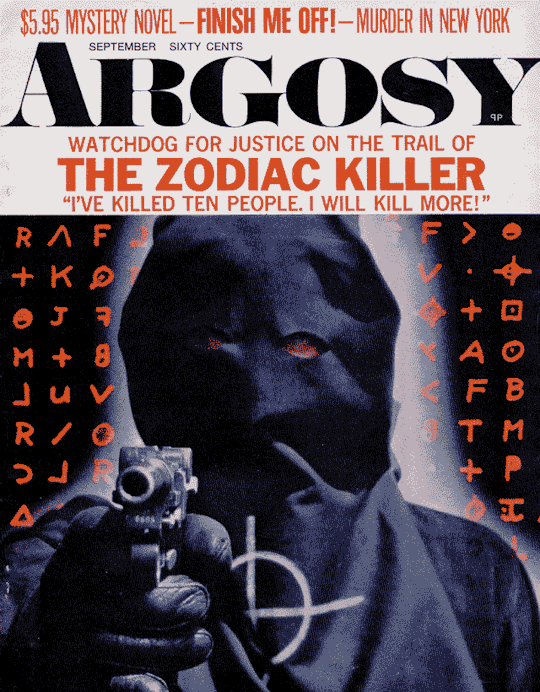
In conclusion, the Zodiac Killer remains one of the most notorious and puzzling serial killers in American history. His cryptic messages and ciphers have added to the mystery of the case and have captivated the public's attention for decades. While the killer was never caught, the case remains open, and the possibility of a breakthrough in the investigation still exists.
0 notes
Photo

Stacey Lauretta Dash (born January 20, 1967) is an actress. She played Dionne Marie Davenport in Clueless and its television series of the same name. She has appeared in the films Moving, Mo' Money, Renaissance Man, and View from the Top. Other television work includes appearances in the series CSI: Crime Scene Investigation, Single Ladies, and Celebrity Circus. She has appeared in music videos for Carl Thomas' "Emotional" and Kanye West's "All Falls Down". Girl,". Born in the Bronx, he is the daughter of Dennis Dash and Linda Dash. Her brother is Darien Dash, who is the founder of DME Interactive. Her cousin is Damon Dash, the former CEO and co-founder of Roc-A-Fella Records. She made her first television appearance in Farrell: For the People. Her first notable appearance was as Michelle on The Cosby Show. Her first substantial television role was in TV 101. Her first major film role was in Moving. She starred in Illegal in Blue. She appeared in View from the Top, Gang of Roses, and Getting Played. She has appeared in small guest roles on television shows such as Eve, and CSI: Crime Scene Investigation. She posed nude in the August 2006 issue of Playboy. She launched a lingerie line called Letters of Marque. She completed filming roles in I Could Never Be Your Woman, Nora's Hair Salon II, Fashion Victim, Ghost Image, and American Primitive. She filmed Phantom Punch, Secrets of a Hollywood Nurse, and Close Quarters. She performed in Celebrity Circus. She appeared as a recurring character in The Game. She starred in Dysfunctional Friends. She was featured in Funny or Die and the web series Stacey Dash Is Normal. She had been hired as a contributor for "cultural analysis and commentary." After several controversial comments, it was announced that her contract would not be renewed. She married producer Brian Lovell (1999- 2005), married British executive James Maby (2005-2006), married actor Emmanuel Xeureb (2007-2011), and married lawyer Jeffrey Marty (2008-2020). She has two children. #africanhistory365 #africanexcellence https://www.instagram.com/p/CnozXm1LgsF/?igshid=NGJjMDIxMWI=
3 notes
·
View notes
Text
Kung fury street rage budget

Kung fury street rage budget android#
Kung fury street rage budget series#
Kung fury street rage budget psp#
If you haven't seen the 30-minute love letter to 80s action excess that is Kung Fury, go watch it now.
Kung fury street rage budget series#
To this day, CHAOS RINGS firmly maintains its position as the best RPG series available for smartphones.Īndroid Police coverage: True Survivors Crotch-Punch Nazis In the Official Kung Fury: Street Rage Mobile Game The rich game world, deep storyline, and high-quality soundtrack have been praised throughout the world, recording over 1.1 million downloads across the series. As part of a continuing series, CHAOS RINGS OMEGA was launched in 2011, followed by CHAOS RINGS II in 2012. The story in part three is only vaguely connected to the first two games, but the interesting combo attack-based combat should feel familiar to fans.ĬHAOS RINGS is a full-scale RPG series for smartphone devices that was first introduced worldwide in 2010. So mobile RPG fans would do well to check out Chaos Rings III, even with its enormous $20 price tag, if you want a new entry in the company's only high-end mobile series. It's a rare day that we see a truly new Square-Enix game, and an even rarer one when that game doesn't include in-app purchases.
Compete against your friends & dominate the leaderboards.Īndroid Police coverage: Square Enix Brings Its Latest Original RPG, Chaos Rings III, To The Play Store For $20.
Replay and uncover more secrets as contracts evolve.
Immersive sniping game based on the Hitman universe.
Eliminate targets, collect weapon parts and complete blueprints to unlock the most powerful rifles. Scope in on your marks using skill, subtlety, subterfuge and the environment to complete your contracts. Take on the role of Agent 47 in Hitman: Sniper - a fixed position shooting game set in beautiful Montenegro. Unfortunately the game is both paid ($5) and includes IAP for upgraded rifles, but that's hardly surprising for a new Square-Enix title. Take out your targets in Silent Scope fashion while using the Hitman series' trademarked creativity to engineer unlikely kills from the environment. You can enjoy the game whose story gave life to the world of Ivalice, and whose high strategy battles bring tactical games to a whole new level.Īndroid Police coverage: Square Enix' Hitman: Sniper Zeroes In On The Play Store And Takes A Covert Shot At Your Free TimeĪgent 47 is usually more of a sneak-up-and-garrote-you kind of hitman, but in this game he's giving his victims a little space.
Kung fury street rage budget psp#
The game grew in popularity upon its re-release in 2007 as Final Fantasy Tactics: The War of the Lions for the PSP with added features such as new movies, scenarios and Jobs. Released as the Final Fantasy series' first tactical RPG in 1997, Final Fantasy Tactics on Playstation went on to sell over 2.4 million copies worldwide.
Kung fury street rage budget android#
This is a port of the PSP remake, but unfortunately it suffers from the usual Square-Enix maladies: high price, low features (no cloud saves, Android TV, or controller support), and even an incorrect aspect ratio.įinal Fantasy Tactics: The War of the Lions has arrived for GooglePlay. The story occurs in its own universe, but the main draw is the tactical combat, which uses large parties, strategic positioning, and an extensive job system. Amazon Appstore - Fearless Fantasy FINAL FANTASY TACTICS : WotLĪndroid Police coverage: Square Enix Ports The PSP Remake Of Fan Favorite 'Final Fantasy Tactics' To Android For $13.99įinal Fantasy Tactics is a sort of spin-off game (that eventually became its own series) to Squaresoft's flagship RPGs.

1 note
·
View note
Text
Alpus jakarta

ALPUS JAKARTA FREE
ALPUS JAKARTA WINDOWS
Alps Industries Limited was founded in 1962 and is based in Ghaziabad, India.
ALPUS JAKARTA WINDOWS
In addition, the company offers automotive/technical textiles and bedding, windows dressings, decorative pillows and accents, table linen, and kitchen linen products. It also provides home textiles, such as drapery, upholstery, blackouts, duvet sets, bed covers and sheets, quilts, pillows, cushion covers, curtains, and table linens cashmere, sheer, and aromatic shawls, scarves, mufflers, stoles, wraps, and other fashion accessories and fabrics for upholstery, including office furniture and automobile seats. The company offers various yarn products, including open end, carded and combed grey single, compact, organic cotton, fair trade cotton, contamination free, slub, core spun lycra, reverse and zero twist, dyed, organic dyed, recycled cotton, and recycled polyester yarns. We also carry out project.Alps Industries Limited manufactures and sells home furnishings, fashion accessories, and yarns in India and internationally. Alpus carry out property developments from start to finish, that is from concept design to sale of the development assets and or handover for operation. The 3 Most Important Stages of Property Developmentīy Alan Edwards | | Uncategorized3 Most Important Stages of Property Development 1 – SITE ANALYSIS AND ACQUISITION Is The Site Developable Or Worth Developing? That Is, Is There Any (Financial) Value To Be Gained From Development? What will the Council, ie the local Planning Authority, allow you to.Īlpus Group Mission Statement And Service Offeringīy Alan Edwards | | UncategorizedAlpus was formed in order to satisfy Customer needs for an Independent Client Representative to take their interests to heart on various types of large projects including complex commercial and residential developments also infrastructure projects involving.īy Alan Edwards | | UncategorizedAlpus Group Alpus Group operates in the UK, Europe, the Middle East and South Africa. The Future Of The European Rail Network and Systems – Did You Watch The RailTech Europe Live 21 Virtual Conference 30th March to 1st April 2021 To Get The Lowdown?īy Alan Edwards | | UncategorizedThe European Rail Network and Systems The RailTech Europe Live 21 Virtual Conference was held from 30th March to 1st April 2021, during which time and over the 3 day event all the major and significant developments and plans for the Future of The European Rail Network. Choices asked me if I would be interested in investing in property in Hungary. How To Avoid Becoming The Victim Of A Scam On Overseas Property Investment – Budapestīy Alan Edwards | | UncategorizedBefore The Financial Crisis 2008/2009 In 2007, i was approached by an agency called Choices with whom I was familiar, and already doing some business in the UK. High Yield Property Investment In The UK Property Marketīy Alan Edwards | | UncategorizedHigh Yield Property Investment In The UK Property Market Posted byadminJune 8, 2021Leave a commenton High Yield Property Investment In The UK Property MarketEditHigh Yield Property Investment In The UK Property Market High Yield Property Investment In The UK Property. Did you know that there are some powerful property investing tools, which most. ALPUS INCREDIBLES 6 Workshop Photo of Building Customer Engagement.
ALPUS JAKARTA FREE
Concurrently the UK has a rising demand.įree Property Training For Property Investors About Purchase Options and Purchase Lease Optionsīy Alan Edwards | | UncategorizedThis article is for the Attention of Property Investors who are interested in hearing about Free Property Training For Property Investors About Purchase Options and Purchase Lease Options. How Can Alpus Help You Solve Your Property Problem Using Class MA Permitted Development Rights?īy Alan Edwards | | UncategorizedThe Economic Background to The Current Situation During the current economic recession, which is the worst in 300 years since the economic depression of 1706, there has been a decline in the demand for retail and office space. The story started in March 2021, when we received notification from a local commercial. The Go/No Go Decision Point And How We Arrived There For A 3 Residential Unit Barn Conversion in West Sussexīy Alan Edwards | | UncategorizedWe recently made the decision not to proceed with a 3 residential unit barn conversion in which we had invested a lot of time, and therefore money from around April 21 to April 22. The site comprises Total Assets of 19 hectares of land in the. Fantastic Hotel & Wildlife Resort Development Opportunity in Botswanaīy Alan Edwards | | Uncategorized2 Plots Near Ikoga Okovango We are presenting a fantastic opportunity for an astute investor to acquire a highly desirable resort and wildlife tourism development site within the Okovengo Delta of Botswana.

0 notes